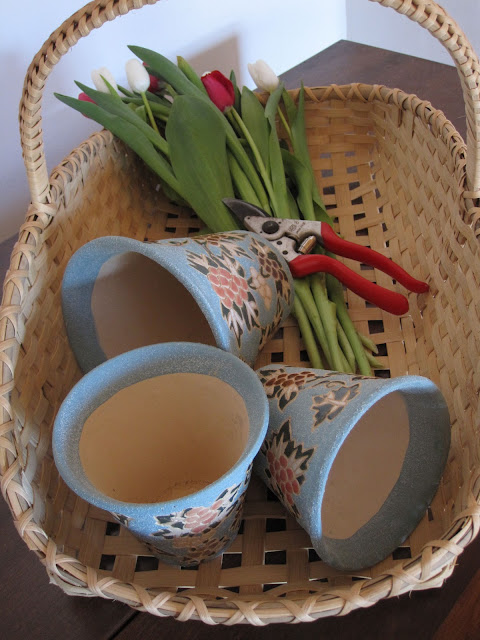"When you give something up,
that's when you start paying attention to it.
And it becomes your subject."
I am a prowler. My stealth attempts to sniff out treasures at flea markets went virtually unnoticed, by everyone, but me. Pretty soon it was clear, my attraction to the shape of things, especially in small objects led to a passion for flower pots.
Trips to Europe were sidelined by detours to antique stores and flea markets.
Trips to Europe were sidelined by detours to antique stores and flea markets.
A Place To Take Root: The History of Flower Pots and Garden Containers in America was a show in Bar Harbor, Maine in 2008.
"The story of the flower pot is that of the development of horticulture. To grow an exotic like an orange tree in Britain, to sprout rare seeds and to root the stems of living plants to produce offspring identical to the parent, gardeners needed a way to control the tender new plant's immediate environment.
ASIAN TOWER
These cheap miniature ceramic pots were purchased in a mile-long Taiwanese flea market, filled with pearls worthy of a Maharahji, bonsai to cry over and cell phones the size of your pinky finger.
A BIT OF ROYALTY
Anyone who has been to a French Chateau recognizes these petite versions of the urns that enliven the French garden. It doesn't matter that the green glaze has all but rubbed off. I love having a reminder of le jardin francais that fits on the end of a thimble.
STILL ON THE SHELF
When you are a veteran of flea markets you often come across goods that have never been used. They still have the original labels, boxes and sometimes, even the price tag. That was the case with these flower pots from the 1930's. I jumped at the chance to buy them.
THE GLAZE THAT TELLS A STORY
This Japanese inspired "cache" pot was made by Malcolm Wright, a potter, living in Marlboro, Vermont. I like to keep it empty. The glaze is as alive as any plant.
NORDIC ZINC
Whether its furniture, porcelain or glassware, I have a passion for all things Scandinavian. The design is always paired down to its essence. During trips to Nordic countries, I stop at garden centers or small florists shops looking for flower pots or containers. I love these zinc pots for their shapes. They make a happy family.
FAUX PAS
There was a period of time when concrete was made to look like wood. It was a popular material for garden furniture and objects. This is a contemporary example of that craze.
It turns out that concrete (opus caementicium) was reinvented by the Romans. They found out that by mixing pozzola (volcanic ash) as a binding agent, the concrete formed made a stronger bond with the aggregates, which allowed pouring, instead of cutting. This lead to the building of phenomenal spans: arches, vaults and domes.
An example of Eric Soderholtz pot -thedowneastdilettante.blogspot.com
Much later in America, Beatrix Farrand discovered that Swedish-born, Eric Soderholtz, an architectural photographer and draftsman had created a formula for pots made out of reinforced concrete that could withstand the severe Maine winters. This tradition continues to day at Lunaform.
DON'T BE SQUARE
These pots are typical of containers from the South of France. The color of the clay tells us so. I was told they were melon pots. This might be true or not. One of the most important criteria for a good flea market salesman is the story they have to tell.
 THROUGH THE RABBIT HOLE
THROUGH THE RABBIT HOLEIf you've tried your hand at throwing a pot or hand-building, you know how hard it is to make something small and delicate. Over the course of a few years, I was able to find smaller and smaller versions of the ubiquitous terra-cotta pot. I have no idea what they could have been used for, but they are marvelous examples of a lost art.
My dollhouse collection of pots sit in my potting shed/woodshed. Every time I need a pair of pruners, twine or shears, I pass my lilliputian shelf. If flower pots are a seedlings first home, then my collection has found its final resting place.
The ultimate garden shelf at the Garden History Museum in London.
______________________________________________
All photos copyright Phyllis Odessey 2011, unless otherwise noted.
______________________________________________
All photos copyright Phyllis Odessey 2011, unless otherwise noted.


















 snap du jour (photo blog)
snap du jour (photo blog)





5 comments:
I like the aricula theater like the one you show as your last pic. So over the top!
AGOG at this amazing, marvelous story, my dear Phyllis -- brava, brava, brava!
love, paula
I love going to the farmer's market for many reasons! Firt of all it gives me a chance to purchase local produce and meats and meet the grower. But more importantly it gives me the opprotunity to teach my son where fruits and vegetables come from and how they are grown. My mother grew up on a farm so I learned first hand how to plant fruits and vegetables and the importance of supporting your local community. I remember going to various farm stands and markets with my parents to buy the freshest fruit we could get and I want my son to have and cherish those same expereinces that I did as a child. :)
nike mercurial
adidas nmd
goyard
converse outlet store
lebron 14
nba jerseys
van cleef arpels
jordan retro 12
kobe 11
lebron shoes
x2e03y6h15 v5k14n8b12 s8g00m9p45 n3i46d9o64 s6e58o6z49 z3i26m5e07
Post a Comment